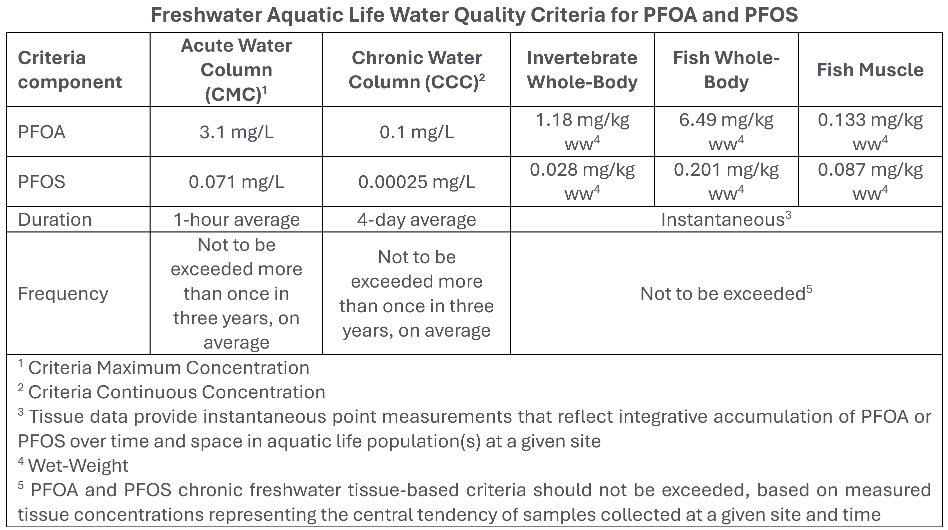
USEPA Recommends Aquatic Life Water Quality Criteria, Benchmarks for 10 PFAS
On October 7, 2024, the United States Environmental Protection Agency (USEPA) finalized a Notice including recommended aquatic life water quality criteria for PFOA and PFOS. Aquatic life criteria are developed under the Clean Water Act and can be used by States and Tribes in developing water quality standards and establishing discharge limits in National Pollutant Discharge Elimination System (NPDES) permits.
Acute and chronic recommended freshwater aquatic life water quality criteria for PFOA and PFOS are provided in the table below. The recommended freshwater acute criteria are up to 42 times lower that the draft values released in 2022 for PFOA and PFOS, respectively. The recommended chronic criterion for PFOA (1 mg/L) is similar to the 2022 draft value (0.094 mg/L), whereas the recommended chronic criterion for PFOS (0.00025 mg/L) is about 32 times lower than the 2022 draft value (0.0084 mg/L).

USEPA also announced aquatic life benchmarks for PFOS and PFOA in saltwater, and aquatic life benchmarks for eight additional PFAS, perfluorobutanoic acid (PFBA), perfluorohexanoic acid (PFHxA), perfluorononanoic acid (PFNA), perfluorodecanoic acid (PFDA), perfluorobutanesulfonic acid (PFBS), perfluorohexanesulfonic acid (PFHxS), hexadecafluoro-2-decenoic acid (8:2 FTUCA), pentadecafluorodecanoic acid (7:3 FTCA) in freshwater. Aquatic life benchmarks are similar to aquatic life criteria but are developed when limited toxicology data are available and, per USEPA, are “estimates of the concentrations below which chemicals are not expected to present a risk of concern for aquatic organisms.” Acute recommended saltwater aquatic life water quality benchmarks for POFA and PFOS and freshwater aquatic life benchmarks for the eight additional PFAS are provided in the tables below.


USEPA Proposes Adding More than 100 PFAS to TRI
On October 8, 2024, USEPA published a Proposed Rule that would add 16 individual PFAS and 15 PFAS categories to the Toxic Release Inventory (TRI) under Section 7321(d) of the 2020 National Defense Authorization Act. In total, these proposed PFAS and PFAS categories represent more than 100 individual chemicals. Currently, the TRI includes 196 PFAS for Reporting Year 2024. A reporting threshold for these PFAS and PFAS categories would be set at 100 pounds annually for manufacture, processing, and other uses, requiring all the PFAS in a given category to cumulatively count towards the 100-pound threshold for that category. Similarly, in some cases, certain PFAS may fall under multiple TRI chemical categories. If a compound falls under two or more listed chemical categories, “the facility must consider the total amount of the compound manufactured, processed or otherwise used that must be applied to the reporting threshold for each category separately.” Public comments on the Proposed Rule can be submitted online until December 9, 2024.
USEPA Issues Fifth TSCA Test Order on PFAS
On October 9, 2024, the USEPA issued a Toxic Substances Control Act (TSCA) Test Order requiring testing on 6:2 fluorotelomer acrylate (6:2 FTAc), a fluorotelomer acrylate-based PFAS that is used in the manufacture of plastics, resins, apparel, and other chemicals. This action was taken under USEPA’s National PFAS Testing Strategy and is the fifth TSCA Test Order issued on PFAS. According to USEPA, “companies subject to the test order may either conduct the tests as described in the order, including testing of [6:2 FTAc] physical-chemical properties and health effects following exposure, or provide [US]EPA with existing information they believe [US]EPA did not identify in its search, but which satisfies the order requirements.” Results from all of the first-tier tests, which include physical properties, hydrolysis as a function of pH, and octanol and organic carbon partitioning coefficients, are required to be submitted to USEPA within 390 days of the effective date of this order.
North Carolina Establishes Groundwater Interim Maximum Allowable Concentrations for Eight PFAS
On October 15, 2024, the North Carolina Department of Environmental Quality (NCDEQ) released Interim Maximum Allowable Concentrations (IMACs) for eight PFAS in groundwater. NCDEQ can establish an IMAC for a substance for which a groundwater quality standard has not already been established. According to the NCDEQ, both IMACS and permanent groundwater quality standards are enforceable standards used to set “the maximum allowable concentrations of contaminants in groundwater which may be tolerated without creating a threat to human health or which would otherwise render the groundwater unsuitable for use as a drinking water source.” The IMACs are included in the table below.

NCDEQ indicated that the IMACs for PFOA and PFOS are below current practical quantitation limits (PQLs) for these compounds of 4 ng/L, as established by EPA Method 1633; therefore, a measurement at or above the proposed PQL would be considered an exceedance. The IMACs will remain valid for 12 months, during which time the DEQ will determine if the IMACs should expire or be replaced with permanent groundwater quality standards.
California Recommends PFHxA Drinking Water Notification Level
On September 18, 2024, the California Office of Environmental Health Hazard Assessment (OEHHA) recommended a health-based notification level (NL) for PFHxA of 1 microgram per liter (µg/L) in drinking water. NLs are nonregulatory, health-based drinking water advisory levels established for contaminants that do not have maximum contaminant levels. If adopted by the State Water Resources Control Board, an exceedance of the NL in drinking water would require consumer notification by the drinking water system. The recommendation is based on OEHHA’s development of a health-protective concentration intended to prevent noncancer effects and developmental toxicity and is derived from a review of available scientific literature.
Australia Proposes Guideline Values for PFAS in Drinking Water
On October 21, 2024, the Australian National Health and Medical Research Council (NHMRC) proposed health-based guideline values for five PFAS in drinking water. Revised Australian Drinking Water Guidelines are proposed for PFOA and the sum of PFOS and PFHxS, and new guideline values are proposed for PFOS, PFHxS, and PFBS. Additionally, a health-based guideline value for GenX chemicals was considered and deemed not to be necessary. Current and proposed guideline values are included in the table below. According to the NHMRC, “Australian Drinking Water Guidelines provide a basis for determining the quality of water to be supplied to consumers in all parts of Australia.” The drinking water guidelines “are not mandatory legally enforceable standards and the implementation of the guidelines is at the discretion of each state and territory.”

Public comments on the proposed guidance values can be submitted online until November 22, 2024. The final guideline values are expected to be published in the April 2025 version of the Australian Drinking Water Guidelines.
European Union Restricts Use and Sale of PFHxA
On October 10, 2024, restrictions on the use and sale of PFHxA and its salts and related compounds went into effect in the European Union (EU). The restriction has implementation timelines ranging from 18 months to 5 years depending on the use category. Under this restriction, PFHxA cannot be sold or used at concentrations greater than 25 parts per billion in applications that include consumer textiles, food packaging, cosmetics, waterproofing sprays, and some firefighting foam applications. The EU indicated that these categories were selected because other risk management measures were not considered sufficient to mitigate emissions related to “wide dispersive consumer uses” of PFHxA.
Geosyntec PFAS Webinar Series
Geosyntec is hosting a PFAS webinar series showcasing a thorough synthesis of the state of knowledge on the management of PFAS-impacted sites. Subject matter experts from Geosyntec and the broader stakeholder community will discuss PFAS key technical, regulatory, and legal issues.
